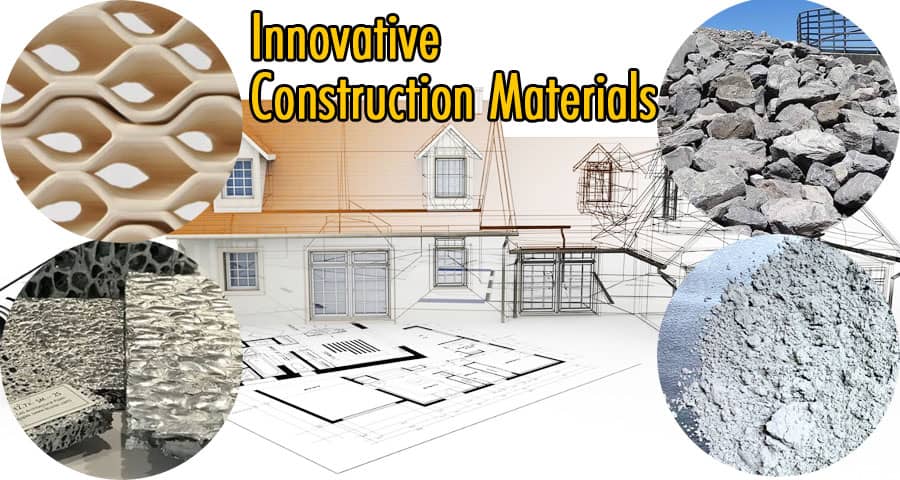20 Innovative Construction Materials

In the ever-evolving world of construction, innovation is the key to progress. Over the years, architects, engineers, and builders have been on a relentless quest to discover materials that not only enhance the structural integrity of buildings but also contribute to sustainability and aesthetics.
Now, let's explore these innovative construction materials in detail.
Smart Concrete: Reinventing Durability
Smart concrete is a revolutionary material that uses embedded sensors to monitor its structural health. It can detect cracks and weaknesses, allowing for timely repairs, thus increasing the lifespan of buildings.
Transparent Aluminum: The Future of Windows
Transparent aluminum, once a science fiction concept, is now a reality. This material is exceptionally strong and durable, making it a promising candidate for future window installations.
Self-healing Concrete: A Marvel of Engineering
Imagine concrete that heals its own cracks. Self-healing concrete uses bacteria or capsules filled with healing agents to repair damage, ensuring the longevity of structures.
Recycled Plastic Bricks: Eco-Friendly Building Blocks
Recycled plastic bricks address both plastic waste and construction needs. These bricks are lighter than traditional ones and offer excellent insulation properties.
Aerogel Insulation: The Ultimate Thermal Barrier
Aerogel is one of the lightest materials known to man. It's used as insulation, offering superb thermal resistance without adding significant weight to structures.
Graphene: Strength in a Single Layer
Graphene, a single layer of carbon atoms, is incredibly strong and conductive. It's being explored for various applications in construction, from stronger concrete to advanced electronics.
Engineered Wood: Timber Reinvented
Engineered wood products like laminated veneer lumber and cross-laminated timber provide sustainable alternatives to traditional timber, reducing deforestation.
Solar Tiles: Powering Homes Sustainably
Solar tiles seamlessly blend into roofing materials, harnessing the power of the sun to generate electricity while maintaining aesthetic appeal.
Biodegradable Geotextiles: A Greener Foundation
Biodegradable geotextiles offer erosion control and soil stabilization without harming the environment. They degrade over time, leaving behind no harmful residues.
3D-Printed Buildings: A Glimpse into the Future
With the help of 3D printing technology, entire buildings can be constructed quickly and efficiently, reducing labor costs and material waste.
BIPV (Building-Integrated Photovoltaics): Merging Solar and Construction
BIPV integrates solar panels directly into building materials, such as roofing and fa�ades, allowing structures to generate their own electricity.
Hempcrete: A Sustainable Alternative to Concrete
Hempcrete is a mixture of hemp fibers, lime, and water, offering excellent insulation and sustainability while reducing the carbon footprint of construction.
Ferrock: The Carbon-Eating Material
Ferrock is a material that actively absorbs carbon dioxide as it cures, making it a green alternative to traditional concrete.
Smart Glass: Windows that Adapt
Smart glass changes its transparency based on external factors like sunlight and temperature, enhancing energy efficiency and comfort.
Superadobe: Sustainable Earthbag Construction
Superadobe uses earth-filled bags and barbed wire to create durable and environmentally friendly structures.
Mycelium Bricks: Growing Your Walls
Mycelium bricks are made from fungus and agricultural waste, offering a biodegradable and sustainable alternative to traditional bricks.
Carbon Fiber Reinforced Polymers: Lightweight and Strong
Carbon fiber reinforced polymers are incredibly strong and lightweight, making them ideal for applications where weight reduction is crucial.
Self-cleaning Coatings: Low-Maintenance Surfaces
Self-cleaning coatings use nanotechnology to repel dirt and grime, reducing the need for frequent cleaning and maintenance.
Nanomaterials: Miniature Wonders in Construction
Nanomaterials are engineered at the nanoscale, offering properties like enhanced strength, durability, and conductivity, which can revolutionize construction.
Conclusion
Innovation in construction materials is not only reshaping the industry but also making it more sustainable and eco-friendly. As these materials continue to evolve, we can expect buildings of the future to be more efficient, durable, and environmentally responsible.
Unique FAQs
Are these innovative materials readily available for construction projects?
While some materials are already in use, others are still in the experimental phase. Availability may vary depending on location and project requirements.
Do innovative construction materials cost more than traditional ones?
Initially, some may have a higher upfront cost, but the long-term benefits, such as energy savings and durability, often outweigh the initial investment.
How do these materials contribute to sustainability?
Many of these materials are eco-friendly, reducing waste, carbon emissions, and the depletion of natural resources.
Are there any drawbacks or limitations to using these materials?
Some materials may have specific application limitations or require specialized installation techniques.
Can homeowners incorporate these materials into their renovation projects?
Yes, many innovative materials are suitable for both large-scale construction projects and home renovations, offering versatility in their application.
